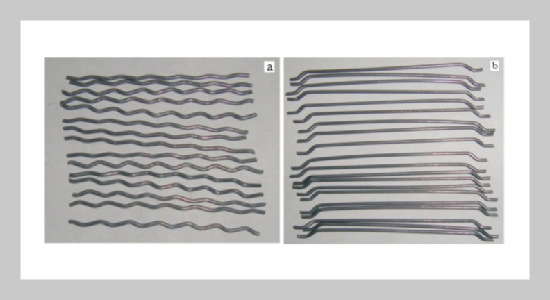REFERENCES
- [1] Nataraja, M. C., Dhang, N. and Gupta, A., “Statistical Variations in Impact Resistance of Steel Fibre-Reinforced Concrete Subjected to Drop Weight Test,” Cement and Concrete Research, Vol. 29, No. 7, pp. 989� 995 (1999). doi: 10.1016/S0008-8846(99)00052-6
- [2] Nataraja, M. C., Nagaraj, T. S. and Basavaraja, S. B., “Reproportioning of Steel Fibre Reinforced Concrete Mixes and their Impact Resistance,” Cement and Concrete Research, Vol. 35, pp. 2350�2359 (2005). doi: 10.1016/j.cemconres.2005.06.011
- [3] Lu, X. and Hsu, C., “Behavior of High Strength Concrete with and without Steel Fibre Reinforcement in Triaxial Compression,” Cement and Concrete Research, Vol. 36, pp. 1679�1685 (2006). doi: 10.1016/j. cemconres.2006.05.021
- [4] Yazici, S., Inan, G. and Tabak, V., “Effect of Aspect Ratio and Volume Fraction of Steel Fibre on the Mechanical Properties of SFRC,” Construction and Building Materials, Vol. 21, pp. 1250�1253 (2007). doi: 10.1016/j.conbuildmat.2006.05.025
- [5] Altun, F., Haktanir, T. and Ari, K., “Effects of Steel Fibre Addition on Mechanical Properties of Concrete and RC Beams,” Construction and Building Materials, Vol. 21, pp. 654�661 (2007). doi: 10.1016/ j.conbuildmat.2005.12.006
- [6] Camps, G., Turatsinze, A., Sellier, A., Escadeillas, G. and Bourbon, X., “Steel-Fibre-Reinforcement and Hydration Coupled Effects on Concrete Tensile Behavior,” Engineering Fracture Mechanics, Vol. 75, pp. 5207�5216 (2008). doi: 10.1016/j.engfracmech.2008. 08.008
- [7] Mohammadi, Y., Singh, S. P. and Kaushik, S. K., “Properties of Steel Fibrous Concrete Containing Mixed Fibres in Fresh and Hardened State,” Construction and Building Materials, Vol. 22, pp. 956�965 (2008). doi: 10.1016/j.conbuildmat.2006.12.004
- [8] Wang, Z. L., Liu, Y. S. and Shen, R. F., “Stress-Strain Relationship of Steel Fibre-Reinforced Concrete under Dynamic Compression,” Construction and Building Materials, Vol. 22, pp. 811�819 (2008). doi: 10. 1016/j.conbuildmat.2007.01.005
- [9] Eren, Ö. and Marar, K., “Effect of Limestone Crusher Dust and Steel Fibre on Concrete,” Construction and Building Materials, Vol. 23, pp. 981�988 (2009). doi: 10.1016/j.conbuildmat.2008.05.014
- [10] Atis, C. D. and Karahan, O., “Properties of Steel Fibre Reinforced Fly Ash Concrete,” Construction and Building Materials, Vol. 23, pp. 392�399 (2009). doi: 10.1016/j.conbuildmat.2007.11.002
- [11] Ding, Y., Zhang, Y., Thomas, A. and Kusterle, W., “The Investigation on Strength and Flexural Toughness of Fibre Cocktail Reinforced Self-Compacting High Performance Concrete,” Construction and Building Materials, Vol. 23, pp. 448�452 (2009). doi: 10.1016/j.conbuildmat.2007.11.006
- [12] Song, P., Wu, J., Hwang, S. and Sheu, B., “Assessment of Statistical Variations in Impact Resistance of HighStrength Steel Fibre-Reinforced Concrete,” Cement and Concrete Research, Vol. 35, No. 2, pp. 393�399 (2005). doi: 10.1016/j.cemconres.2004.07.021
- [13] Atef, B., Ashraf, F. and Andrew, K., “Statistical Variations in Impact Resistance of Polypropylene Fibre-Reinforced Concrete,” International Journal of Impact Engineering, Vol. 32, pp. 1907�1920 (2006). doi: 10.1016/j.ijimpeng.2005.05.003
- [14] Wang, Z., Liu, Y. and Shen, R., “Stress-Strain Relationship of Steel Fibre Reinforced Concrete under Dynamic Compression,” Construction and Building Materials, Vol. 22, pp. 811�819 (2008). doi: 10.1016/ j.conbuildmat.2007.01.005
- [15] Mahmoud, N. and Afroughsabet, V., “Combined Effect of Silica Fume and Steel Fibres on the Impact Resistance and Mechanical Properties of Concrete,” International Journal of Impact Engineering, Vol. 37, pp. 879�886 (2010). doi: 10.1016/j.ijimpeng.2010. 03.004
- [16] Alavi Nia, A., Hedayatian, M., Nili, M. and Afrough Sabet, V., “An Experimental and Numerical Study on How Steel and Polypropylene Fibres Affect the Impact Resistance in Fibre-Reinforced Concrete,” International Journal of Impact Engineering, Vol. 46, pp. 62�73 (2012). doi: 10.1016/j.ijimpeng.2012.01.009
- [17] ACI Committee 544.2R-89, Measurement of Properties of Fibre Reinforced Concrete, Detroit: American Concrete Institute (1989).
- [18] Taner Yildirim, S., Cevdet, E. and Fehim Findik, E., “Properties of Hybrid Fibre Reinforced Concrete under Repeated Impact Loads,” Russian Journal of Nondestructive Testing, Vol. 46, No. 7, pp. 538�546 (2010). doi: 10.1134/S1061830910070090
- [19] Mohammadi, Y., Carkon-Azad, R., Singh, S. P. and Kaushik, S. K., “Impact Resistance of Steel Fibrous Concrete Containing Fibres of Mixed Aspect Ratio,” Construction and Building Materials, Vol. 23, pp. 183�189 (2009). doi: 10.1016/j.conbuildmat.2008. 01.002
- [20] Chen, X. Y., Ding, Y. N. and Azevedo, C., “Combined Effect of Steel Fibres and Steel Rebars on Impact Resistance of High Performance Concrete,” J Cent South Univ Technol, Vol. 18, pp. 1677�1684 (2011). doi: 10.1007/s11771-011-0888-y
- [21] ACI 228R-98, Nondestructive Test Methods for Evaluation of Concrete in Structures, ACI Manual of Concrete Practice, ACI, USA, Vol. 62 (2000).
- [22] IS: 13311(PT1)-1992, Methods of Non-Destructive Testing of Concrete: Part 1 Ultrasonic Pulse Velocity, Bureau of Indian Standards, New Delhi, India.
- [23] IS: 383-1970, Specification for Coarse and Fine Aggregates from Natural Sources for Concrete , Bureau of Indian Standards, New Delhi, India.
- [24] IS: 456-2000, Code of Practice for Plain and Reinforced Concrete, Bureau of Indian Standards, New Delhi, India
- [25] Swamy, R. N. and Jojagha, A. H., “Impact Resistance of Steel Fibre Reinforced Lightweight Concrete,” The International J of Cement Composites and Light Weight Concrete, No. 4, pp. 209�220 (1982). doi: 10.1016/0262-5075(82)90024-0
















